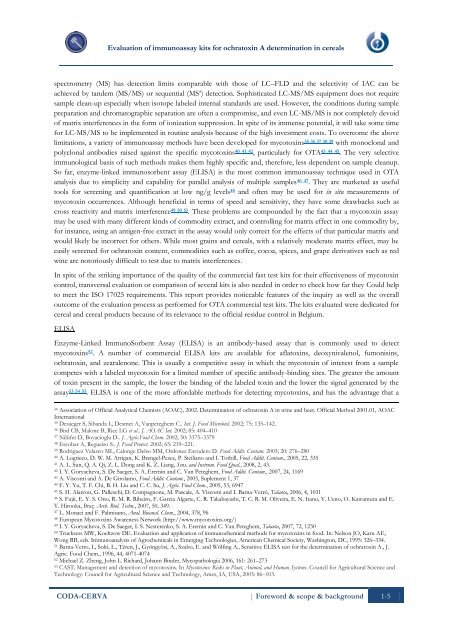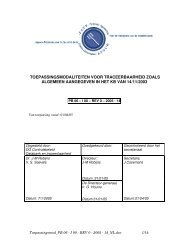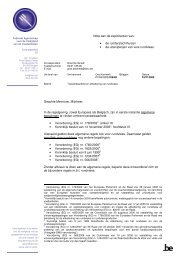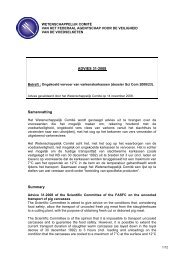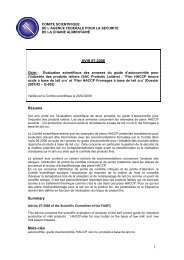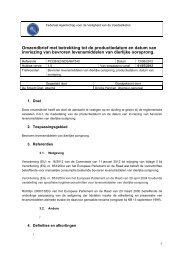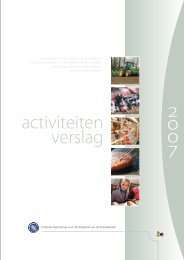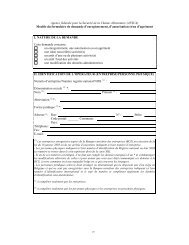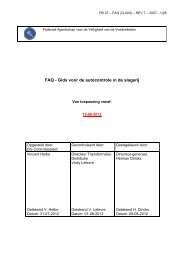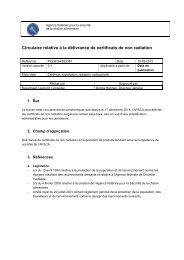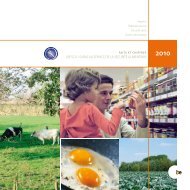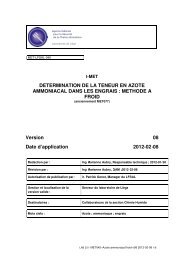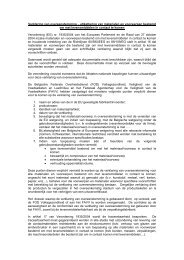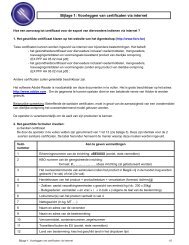Document - FAVV
Document - FAVV
Document - FAVV
- No tags were found...
You also want an ePaper? Increase the reach of your titles
YUMPU automatically turns print PDFs into web optimized ePapers that Google loves.
Evaluation of immunoassay kits for ochratoxin A determination in cerealsspectrometry (MS) has detection limits comparable with those of LC–FLD and the selectivity of IAC can beachieved by tandem (MS/MS) or sequential (MS n ) detection. Sophisticated LC-MS/MS equipment does not requiresample clean-up especially when isotope labeled internal standards are used. However, the conditions during samplepreparation and chromatographic separation are often a compromise, and even LC-MS/MS is not completely devoidof matrix interferences in the form of ionization suppression. In spite of its immense potential, it will take some timefor LC-MS/MS to be implemented in routine analysis because of the high investment costs. To overcome the abovelimitations, a variety of immunoassay methods have been developed for mycotoxins 35 36 37 38 39 with monoclonal andpolyclonal antibodies raised against the specific mycotoxins 40 41 42 , particularly for OTA 43 44 45 . The very selectiveimmunological basis of such methods makes them highly specific and, therefore, less dependent on sample cleanup.So far, enzyme-linked immunosorbent assay (ELISA) is the most common immunoassay technique used in OTAanalysis due to simplicity and capability for parallel analysis of multiple samples 46 47 . They are marketed as usefultools for screening and quantification at low ng/g levels 48 and often may be used for in situ measurements ofmycotoxin occurrences. Although beneficial in terms of speed and sensitivity, they have some drawbacks such ascross reactivity and matrix interference 49 50 51 . These problems are compounded by the fact that a mycotoxin assaymay be used with many different kinds of commodity extract, and controlling for matrix effect in one commodity by,for instance, using an antigen-free extract in the assay would only correct for the effects of that particular matrix andwould likely be incorrect for others. While most grains and cereals, with a relatively moderate matrix effect, may beeasily screened for ochratoxin content, commodities such as coffee, cocoa, spices, and grape derivatives such as redwine are notoriously difficult to test due to matrix interferences.In spite of the striking importance of the quality of the commercial fast test kits for their effectiveness of mycotoxincontrol, transversal evaluation or comparison of several kits is also needed in order to check how far they Could helpto meet the ISO 17025 requirements. This report provides noticeable features of the inquiry as well as the overalloutcome of the evaluation process as performed for OTA commercial test kits. The kits evaluated were dedicated forcereal and cereal products because of its relevance to the official residue control in Belgium.ELISAEnzyme-Linked ImmunoSorbent Assay (ELISA) is an antibody-based assay that is commonly used to detectmycotoxins 52 . A number of commercial ELISA kits are available for aflatoxins, deoxynivalenol, fumonisins,ochratoxin, and zearalenone. This is usually a competitive assay in which the mycotoxin of interest from a samplecompetes with a labeled mycotoxin for a limited number of specific antibody-binding sites. The greater the amountof toxin present in the sample, the lower the binding of the labeled toxin and the lower the signal generated by theassay 53 54 55 . ELISA is one of the more affordable methods for detecting mycotoxins, and has the advantage that a34Association of Official Analytical Chemists (AOAC), 2002. Determination of ochratoxin A in wine and beer. Official Method 2001.01, AOACInternational35Desaeger S, Sibanda L, Desmet A, Vanpeteghem C.. Int. J. Food Microbiol. 2002; 75: 135–142.36Bird CB, Malone B, Rice LG et al.. J. AOAC Int. 2002; 85: 404–41037Nilüfer D, Boyacioglu D.. J. Agric.Food Chem. 2002; 50: 3375–337938Escobar A, Regueiro S.. J. Food Protect. 2002; 65: 219–221.39Rodriguez Velasco ML, Calonge Delso MM, Ordonez Escudero D. Food Addit. Contam. 2003; 20: 276–28040A. Logrieco, D. W. M. Arrigan, K. Brengel-Pesce, P. Siciliano and I. Tothill, Food Addit. Contam., 2005, 22, 33541A. L. Sun, Q. A. Qi, Z. L. Dong and K. Z. Liang, Sens. and Instrum. Food Qual., 2008, 2, 43.42I. Y. Goryacheva, S. De Saeger, S. A. Eremin and C. Van Peteghem, Food Addit. Contam., 2007, 24, 116943A. Visconti and A. De Girolamo, Food Addit. Contam., 2005, Suplement 1, 3744F. Y. Yu, T. F. Chi, B. H. Liu and C. C. Su, J. Agric. Food Chem., 2005, 53, 694745S. H. Alarcon, G. Palleschi, D. Compagnone, M. Pascale, A. Visconti and I. Barna-Vetró, Talanta, 2006, 4, 103146S. Fujii, E. Y. S. Ono, R. M. R. Ribeiro, F. Garcia Algarte, C. R. Takabayashi, T. C. R. M. Oliveira, E. N. Itano, Y. Ueno, O. Kawamura and E.Y. Hirooka, Braz. Arch. Biol. Techn., 2007, 50, 349.47L. Monaci and F. Palmisano, Anal. Bioanal. Chem., 2004, 378, 9648European Mycotoxins Awareness Network (http://www.mycotoxins.org/)49I. Y. Goryacheva, S. De Saeger, I. S. Nesterenko, S. A. Eremin and C. Van Peteghem, Talanta, 2007, 72, 123050Trucksess MW, Koeltzow DE. Evaluation and application of immunochemical methods for mycotoxins in food. In: Nelson JO, Karu AE,Wong RB, eds. Immunoanalysis of Agrochemicals in Emerging Technologies, American Chemical Society, Washington, DC, 1995: 326–334.51Barna-Vetro, I., Solti, L., Téren, J., Gyöngyösi, A., Szabo, E. and Wölfing A., Sensitive ELISA test for the determination of ochratoxin A., J.Agric. Food Chem., 1996, 44, 4071-407452Michael Z. Zheng, John L. Richard, Johann Binder, Mycopathologia 2006, 161: 261–27353CAST. Management and detection of mycotoxins. In Mycotoxins: Risks in Plant, Animal, and Human Systems. Council for Agricultural Science andTechnology: Council for Agricultural Science and Technology, Ames, IA, USA, 2003: 86–103.CODA-CERVA | Foreword & scope & background 1-5


